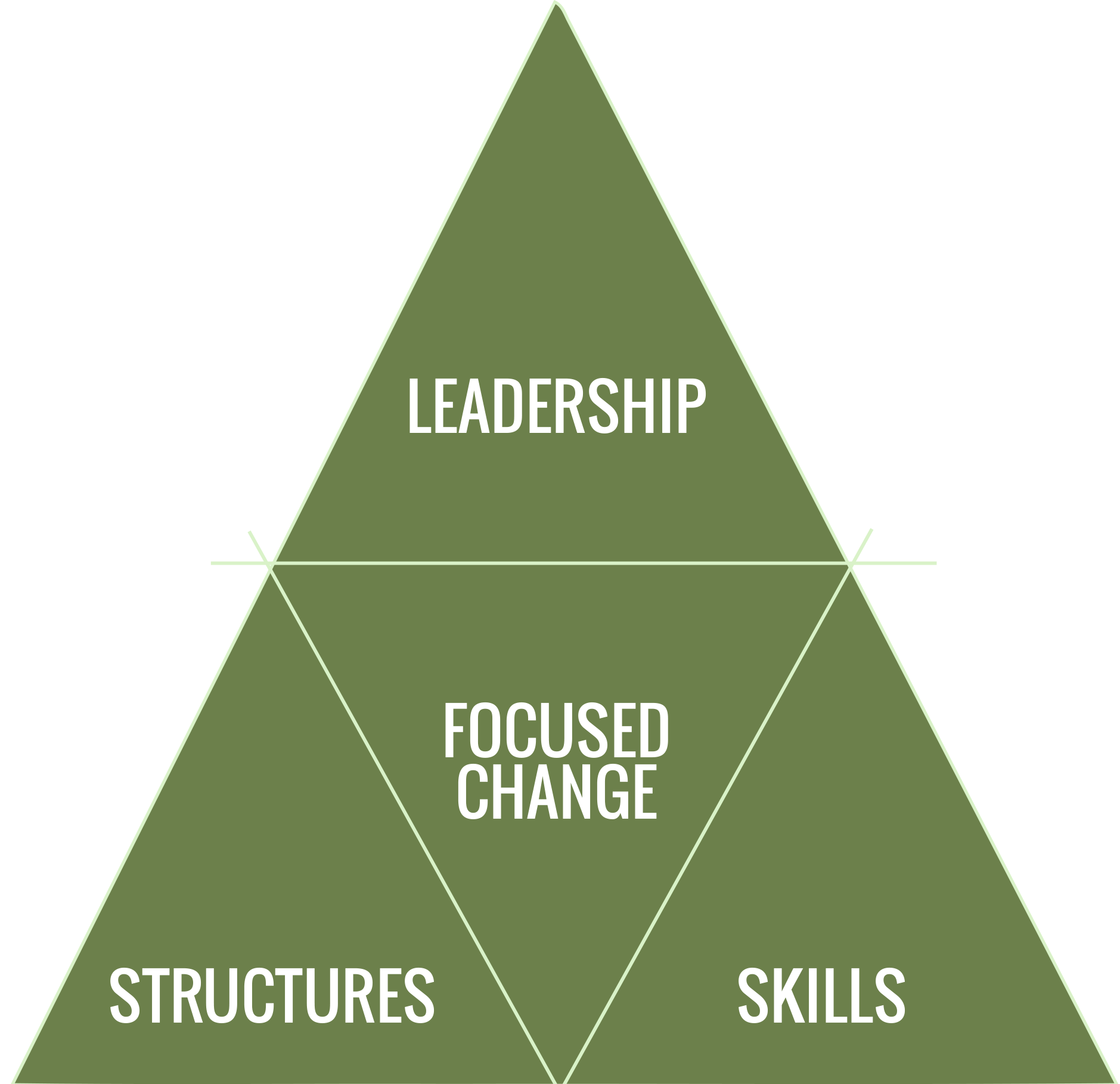
HOW TO USE STRUCTURES AND SUPPORT
FOR LASTING CHANGE
– Chapter 4 –
The role of structures & support
The finalise phase of change management is to provide structures and support. Structures and support will help you overcome ambiguity and the evils of the fundamental attribution error.
You’ll need to provide bright lights to lead the way, engage influential people as exemplars, and kindly but firmly ask people to let go.

Force people to let go
 A few years ago I started Crossfit as a way to get fit. Crossfit is a multi-disciplinary fitness method that has you Olympic lifting, doing gymnastics and high intensity aerobic training.
A few years ago I started Crossfit as a way to get fit. Crossfit is a multi-disciplinary fitness method that has you Olympic lifting, doing gymnastics and high intensity aerobic training.
I became attracted to the Olympic lifting. While it seems simple, the idea of lifting a loaded bar from the ground and throw it over your head, is anything but.
I would grab the bar and lift with an almighty speed and sort of “muscle” the bar up, hoping it would not fall on my head. That worked at lower weights, but pretty soon I hit a plateau.
After many failed attempts, I realised that my gym buddies of similar size and strength were able get much heavier weights above their head. It amazed me.
Now, the proper way to lift is to not hold on to the bar so tight and not grip the bar so high into the lift. Instead you must sort of ‘let go’ of the bar and ‘catch’ it just as it starts to come down.
Once I did that I realised the bar had its own momentum, lifting much heavier weights became relatively easier.
The same is true in life. We need to let go to reach out. We need to stop holding on so tight.
We need to create the space so the new change can grow and become comfortable.
Use these three techniques to encourage people to move with the momentum of change:

- THE CUT OFF: At some stage, the old system needs to be switched off.
- THE MOVE FORWARD: No longer accept information via emails or online forms.
- THE INCENTIVE: The first people to embrace this will get some new benefit.
You might need to pry people’s fingers away while they hold on for dear life, but once you do, you’ll see them roll with the momentum of the future. Just don’t mistake their shrieks for real resistance.
Engaging exemplars
Outside of the middle leaders, also look for those informal leaders who by their expertise or tenure can provide leadership. Let these “point people” know they are instrumental in leading the change and will be fulfilling an important role.
Provide them with as much clarity as you can to help deliver the message:
- You have a key position in the new arrangements and so we need your help to lead and drive the change
- You’ll be a leader of the new organisation and so I need your help now
- I’d like your input and help to make this change a reality, to avoid risks and mistakes, given you know the detail better than I

People tend to respond well to informal leadership. If respected colleagues begin to display new behaviours others will soon adopt them too.
These same people are also they are likely to be subject matter experts and can help navigate the ambiguous zone. Thus avoiding problems otherwise lurking in the fog.
Use bright lights
 There must be clarity around the initial key steps required to make the change happen.
There must be clarity around the initial key steps required to make the change happen.
People don’t need to understand the whole journey in detail, but they do need to have enough clarity on how it will begin.
It is the change managers job to shine a light into the dark so that people can see how they can move forward. This helps people understand expectations of them, and what they need to avoid.
Clarify the specific steps that will be taken to make the change happen, and give people the information, skills and tools necessary for them to let go of the current ways of working and move, with confidence, to the new system.
If people know they positives, and negatives of the proposal and have a sense that you’re being honest with them about them – as well as not deluded – they’ll be more inclined to make intelligent decisions about they’re involvement.
CONSIDER THESE POINTS:
- Don’t make promises you can’t keep or just tell people what you think they want to know. Give them honest and upfront assurances about what you do know. For example, you could say “I don’t know how many job roles will be affected, but the analysis is underway and we should know in a month.” Be sure to get back to them on time.
- If you don’t know, tell them. Too often managers don’t want to say anything at all. When the details are not clear, sometimes it is better to say just that. Say, “this is the current state of play and here’s what we’re doing about it.” Provide a feedback mechanism, such as open meeting forums, or anonymous online tools. Respond quickly to rumours and dispel myths.
- Do the right thing. If you sense something is wrong and people will be otherwise harmed, stop. As you move through the ambiguous fog, remember that there is no perfect way. Use your judgement, values and experience to guide you. Be quick to clarify issues and keep people informed and you’ll make it through.
Six steps to change
Having covered the philosophy of what works and what to look out for in change, now is the time to create a solid plan to execute.
While filled with ambiguity and potential mine fields, change shouldn’t be random, uncontrolled. Effective change management means applying a structured approach. A structure will ensure successful outcomes that are in line with the intention of the vision.
THE FOLLOWING 6 STEPS ARE ESSENTIAL FOR EFFECTIVE IMPLEMENTATION:
-

Align and involve key people. To ensure momentum and engagement in a change process, identify all key stakeholders. It is vital to ensure everyone is included and no on is left out. (People just hate, hate, hate being left out.) Choose the informal change champions and use this team as agents of change across the wider organisation. Remember, while you need people in formal positions of power, you need a diversity of skills, authority, resources and leadership.
- Create a plan. The first step in avoiding ‘ambiguous zone’ is to create a clear and simple plan which defines roles and responsibilities. Then get people involved. Break the plan into small, achievable chunks.
-

Focus on exemplars of the desired behaviours. Each change initiative will have differing focus. It could be cutting costs or a system implementation. Whatever the focus it’s important the key leaders and the project team are acting as exemplars, modelling the the behaviour they wish to see. If you want to cut costs, don’t order new computers when the current ones will do.
- Enabling structures and support. The environment matters. Studies show that people eat less food when served on a smaller plate. Structures and supporting tools do much the same thing in organisations. By providing triggers and reinforcement to adopt the new ways of working people will adopt the new change faster.
- Celebrate successes. Now, this doesn’t have to be a gala event. Although it might. Often a simple “well done, and thanks for your efforts” is enough acknowledgement. It keeps people motivated and gives them a sense of progress along the right path. Recognising progress will maintain motivation, stakeholder interest, and give confidence that the longer term vision is achievable.
-

Communicate continuously. It’s tempting to stop communicating when things aren’t going well or when things are uncertain. But these are both terrible reasons to not communicate. These are the times to do the opposite and step up the communications. It is through communication that you shift people’s attitudes, beliefs, and overcome resistance.
Weekly checklist
| HAVE I? | Y/N & COMMENTS |
|---|---|
| Specified the nature of the change
What’s changed? What else have I discovered? Have I communicated that message? |
|
| Explained why
Do I fit my communications into the wider context and explain how it fits? |
|
| Explained the change, good and bad
Am I maintaining my consistency, openness, and tackling all aspects of the change? |
|
| Developed creative communication
What have I done differently this week? What will I do differently next week? |
|
| Managed the negatives
What might be perceived as negative? Do I have it covered? |
|
| Explained what success looks like
Are we working to the same vision? As each other? As last week? Am I sure it’s explicit and clear? |
|
| Explained what’s in it for people
Is my team aware of the impact of the change on themselves, the potential benefits, and the difficulties involved? |
|
| Repeated myself!
Even though I may have said it before, have I said it again? |
|
| Made communication two-way
Who has or has not communicated back to me? Have I established two-way communication and more importantly, are people using it? |
|
| Been a change figurehead
How have I been consistent this week? Am I a change leader? |
|
| Action Plan Y/N |
Conclusion
To create focused change you need to intersection of these three points:
- Leadership
- Skills
- Structures
Leadership with enabling structures but no skills results in a good idea, but nothing to do.
Leadership with skills, but no structures results in confusion.
Skills and structures without leadership is a rudderless ship.
As change managers, you need to bring the three together to ensure focused and rapid change.

As a final message, remember this: changing the status quo is difficult. And while nothing happens until top leadership is engaged, the power and momentum is in the middle.
GET ON THE FRONT FOOT, ENGAGE THE FRONTLINE
AND INFORMAL LEADERSHIP THROUGHOUT THE ORGANISATION.
Change will then take on a power of its own.




